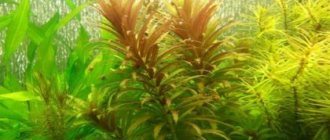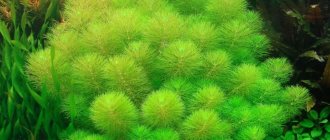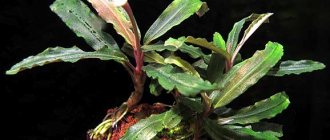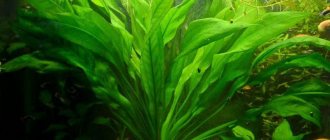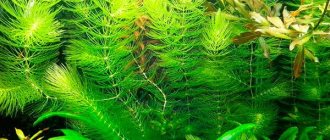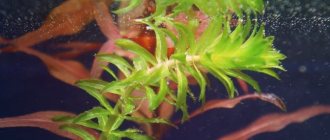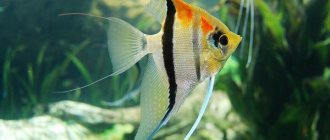There are plants that in the aquarium hobby are classified as so-called “lungs”. That is, they are recommended to people who are just starting to master this very interesting hobby and take their first steps in this area. Without any doubt, the aquarium plant Limnophila belongs to this option.
Limnophila is a plant of the Norichnikov family. Previously, another name was also popular - Ambulia. Nowadays it is found extremely rarely, for example, in old reference books or in the oral speech of some aquarists.
general description
In their natural habitat, Limnophila can most often be found on the coasts of the Indian Ocean: in Australia, in eastern Africa, in the southern regions of Asia.
The stem of this plant is erect and can reach a height of up to one meter. The leaves are in a whorl. They differ in surface and underwater. The first ones are lanceolate-shaped, with brightly visible teeth on the edges. The second ones are thin, dissected, multi-pinnate. If the height of the plant is sufficient to rise above the surface of the water, then Limnophila can please others with its flowering.
The root system is thread-like, thin, but quite strong.
This plant was first described in 1810; today the genus consists of 35 known and fairly well studied species.
Limnophiles are also distinguished by the presence of a so-called diurnal cycle - in the evening you can observe how the upper part of the leaves folds into a single whole. In the morning they are again in an open state.
Features of reproduction
There are several ways to propagate Limnophila. The first is by cutting the stem. To do this, cut off the top cutting, at least 10 cm long, and plant it in the ground. The root system is formed quite quickly, and the shoot quickly takes root.
The second method is by dividing the rhizome. It is necessary to divide the root into several parts, making sure that each has a vertical stalk with roots.
Conditions of detention/requirements
Of the more than three dozen species of Limnophila, there is a certain number that are quite actively used in the aquarium hobby. For these options there are several general conditions for their successful maintenance:
- The temperature in the aquarium varies from twenty to thirty degrees Celsius.
- For normal plant development, moderate lighting is usually required.
- Water acidity is neutral, hardness is medium.
That is, the conditions for keeping Limnophila in aquariums are quite acceptable. But you should not go beyond the recommended parameters, as in this case the plant can easily die.
Ambulia or Limnophila aquarium plant, photo
Ambulia or Limnophila, originally from India and Sri Lanka, appeared on sale for aquariums relatively recently. Limnophila, which means “pond-loving”, grows along the edges of fresh water bodies without a stormy current. It is rightfully one of the most beautiful plants. It has a tall stem, reaching from 60 cm to 1 meter.
Perfect for decorating the back wall of large aquariums; some types of Limnophila are suitable for the middle ground. The plant needs space for full development, so it is advisable not to plant any more plants nearby. Dense thickets of lush emerald-colored bushes will become a refuge for small fish and a playground for fry.
Table of basic maintenance and care parameters:
| What should be the temperature in the aquarium? | from +22-28° C |
| What pH should be in the aquarium? | from 5-8 pH |
| What should be the hardness of the water in the aquarium? | 6-12°dkH |
| What should be the substrate for an aquarium? | soil with granule size from 3-5 mm |
| What kind of lighting should be in the aquarium? | bright-moderate |
| Maximum ambulatory length | up to 0.50 cm |
| Difficulty in keeping limnophila | unpretentious, great for beginners |
The benefits of the presence of Limnophila in the aquarium
It is no secret that aquarists prefer to use many plants for their own purposes, not only because of their decorative qualities. Limnophila also has a number of additional and very useful features:
- This plant is an excellent natural refuge for fry and small fish, which can find protection in it from the encroachments of larger and more aggressive inhabitants of the aquarium.
- The presence of Limnophila in the aquarium helps to saturate the water with oxygen, which has a beneficial effect on the microclimate.
In addition, this aquarium plant is a natural filter, collecting all the dirt present in the water on its leaves. Naturally, you will have to periodically remove it from the water to clean it from dirt.
By the way, some species of Limnophila are specially grown in Vietnam. The fact is that they have a characteristic lemon flavor, which allows this plant to be actively used in cooking.
Aquadesign
The very rapid growth of Limnophila sessile flower limits its use in aquatic design. This plant can be used for background. Although low lighting can make Limnophila more manageable and its growth slower and more compact. The plant's small, needle-like leaves can be an interesting addition to a planted aquarium.
Limnophila is a genus of flowering plants in the plantain family (Plantaginaceae). It is distributed in tropical and subtropical regions of Africa, Asia, Australia and the Pacific Islands. Grows in moist or aquatic environments.
Limnophila / Ambulia and its varieties are a long-stemmed, fast-growing aquarium plant.
Types and their description.
Such a plant simply could not remain without the attention of aquarists. And they were indeed able to find a sufficient number of species suitable for use for their own purposes:
Limnophila aquatic (Ambulia)
Limnophila Aquatic (Ambulia)
Other names - Limnophila giant, Limnophila royal. The leaves are collected in whorls of 4-12 pieces, their diameter can ultimately reach twelve centimeters! The stem is vertical, up to 6 millimeters thick. Content Features:
- Habitat: India and Sri Lanka.
- The root system is strong and white.
- The soil is small pebbles or sandstone, with a grain diameter of 3-5 millimeters.
- The lighting is bright, for ten to twelve hours a day.
- Water parameters: hardness indicators do not play a special role for this species, but acidity should be in the range of 6-0-8.0.
- Temperature – from 24 to 28 degrees. You should not lower it below 22 degrees, as this is a very heat-loving plant.
- Change water at least once a week - up to a quarter of the original volume.
- Placement in the aquarium - in the background.
- Special conditions - some fish like to eat this plant, some aquarists even specially grow it as a herbal supplement.
The leaves and stem of this species are very delicate and fragile, so they must be handled with extreme caution.
Limnophila indica
Limnophila indica
One of the most popular species in the aquarium hobby, which allows you to very quickly get at your disposal dense, lush thickets of a light green plant, the height of which can reach fifty centimeters. Peculiarities:
- Habitat: Australia, Africa, Southeast Asia.
- The root system is well developed.
- The soil is fine-grained sand.
- Lighting – 0.75 W per liter of aquarium water.
- Water parameters: hardness – about 10, acidity – 6.5-8.0.
- Temperature – from 23 to 26 degrees Celsius.
- Water changes are weekly, up to 25 percent of the volume.
- Placement in the aquarium - near the side walls or in the background in a group.
Special conditions - in small aquariums, cuttings should be pre-washed when transplanting, as they can release substances that are toxic to some fish.
Limnophila sessile-floral
Limnophila sessile-floral
In good conditions, it creates a lush green bush that looks very impressive from above. The leaves reach a length of three centimeters. Peculiarities:
- Habitat: swamps and stagnant bodies of water in Africa and Asia.
- The root system is weak.
- The soil is fine river sand without any large fractions.
- Lighting - from 0.5 W per liter of water, for ten hours daily.
- Water parameters: hardness – 6-12, acidity – 6.0-7.5.
- Temperature – from 18 to 30 degrees Celsius.
- Placement in the aquarium - in a group in the background or similarly in the side areas.
- Special conditions – absolutely no mineral fertilizing is required.
One of the most undemanding species, even in such an undemanding family as Limnophila. For example, this option can perfectly tolerate sudden changes in water hardness (from 0 to 20). Or reducing the temperature of the aquarium water to 14-15 degrees - for quite a long time. That is, an almost ideal option for the most inexperienced aquarists.
Limnophila aromatica
Limnophila aromatica
A distinctive feature of this species is its pleasant smell. In fact, it was thanks to him that this species got its name. The leaves can reach 6.5 centimeters in length. Coloring ranges from light green to reddish. Content Features:
- Habitat: Southeast Asia.
- The root system is well developed.
- The soil is river sand or small pebbles with good siltation.
- Lighting - at least 1 W per liter of water in the aquarium. Daylight hours are 10-12 hours.
- Water parameters: the color of the leaves greatly depends on the hardness indicators. In soft water they have a standard light green color, but if the hardness exceeds eight degrees, the foliage can turn burgundy, even purple, acquiring additional splendor. Acidity – 5.5-7.0.
- Temperature - from 22 to 27 degrees Celsius.
- Water changes are weekly.
- Placement in the aquarium - in the background as a group.
- Special conditions – in Southeast Asia it is popular as one of the culinary spices.
It grows extremely slowly and necessarily requires carbon dioxide feeding. You will also need constant and correct addition of micro and macroelements. This species is quite difficult to grow, but it is worth it.
Limnophilia Vietnam mini
Limnophilia Vietnam mini
The species is quite young on the market, but due to its relative undemanding nature, it has already begun to enjoy popularity. Especially for beginner aquarists. Peculiarities:
- Habitat: Vietnam.
- The soil is fine silted gravel or river sand.
- Lighting – from 0.7 W per liter of water in the aquarium.
- Water parameters: hardness – 2-12, acidity – 5.0-7.0.
- Temperature - from 22 to 27 degrees Celsius.
- Water changes are weekly, up to a quarter of the original volume.
- Placement in an aquarium – the plant does not differ in size, so it can be placed absolutely anywhere.
- Special conditions - with good lighting intensity, the plant acquires a very interesting red-brown color.
The species is fast-growing, although its height does not exceed ten centimeters. Therefore, even if it is damaged by aquarium species, the plant will quickly restore its former beauty.
Limnophila sp. “Belem”
Limnophila sp. “Belem”
Previously, this species was considered very popular, especially among beginners, inexperienced aquarists, but today it has been somewhat forgotten. But in vain, because growing it is not very difficult, which allows you to very quickly get quite nice, dense and lush thickets. Peculiarities:
- The root system is weak.
- The ideal soil is fine river sand, without any addition of larger fractions, which can easily damage the roots of this plant.
- The lighting is bright, for ten to twelve hours a day. It is recommended to use fluorescent lamps as an additional source of lighting.
- Water parameters: hardness – 6-12, acidity – within the usual limits for this plant.
- Temperature – from 18 to 30 degrees Celsius.
- Placement in the aquarium - in the background.
This species takes root very quickly after replanting - new cuttings form a full-fledged root system in less than a week. It has been noted that the growth rate of this species depends on the temperature of the aquarium water. No additional feeding is required - it is enough for Limnophila that it enters the aquarium at the same time as the fish food.
Useful lifehacks
To promote better plant growth, we offer advice from practicing aquarists:
- The quality and intensity of lighting can be assessed by the condition of the tops. If there is enough light, the leaves located in the upper zone rise up. Folding as they grow, they seal the stem growth point.
- To achieve a red tint on the leaves, you should regularly enrich the soil with iron.
- Since Limnophila naturally grows in areas of standing water or in bodies of water with weak currents, the plant should not be placed near a compressor or filter.
- With a lack of light, the stem of the plant becomes elongated, and the compactness and splendor of the bush is lost. To avoid this, you need to organize the supply of carbon dioxide.
- The optimal distance between the branches of the plant is from 3 to 4 cm.
- Limnophila sessile flower is not suitable for small aquariums because, as it grows, it displaces neighboring bushes.
- When installing lighting fixtures, you should take into account that the leaves of the plant rise and fold with the onset of darkness. During the day they return to their original position, forming a lush crown. This feature is independent of artificial lighting.
- Since Limnophila prefers warm water, from 24 to 28 ° C, most popular ornamental fish can be placed in an aquarium with this plant.
- If the height of the water column is less than 50 cm, the top of the bush will spread over the surface, which negatively affects the decorative qualities of the bush.
